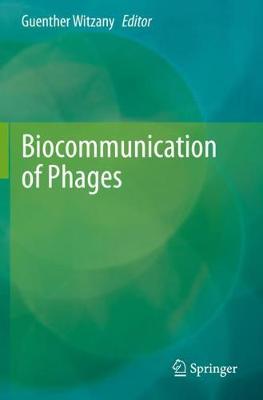MORE ABOUT THIS BOOK
Main description:
This is the first book to systemize all levels of communicative behavior of phages. Phages represent the most diverse inhabitants on this planet. Until today they are completely underestimated in their number, skills and competences and still remain the dark matter of biology.
Phages have serious effects on global energy and nutrient cycles. Phages actively compete for host. They can distinguish between 'self' and 'non-self' (complement same, preclude others). They process and evaluate available information and then modify their behaviour accordingly. These diverse competences show us that this capacity to evaluate information is possible owing to communication processes within phages (intra-organismic), between the same, related and different phage species (interorganismic), and between phages and non-phage organisms (transorganismic). This is crucial in coordinating infection strategies (lytic vs. lysogenic) and recombination in phage genomes.
In 22 chapters, expert contributors review current research into the varying forms of phage biocommunication and Phagetherapy.
Biocommunication of Phages aims to assess the current state of research, to orient further investigations on how phages communicate with each other to coordinate their behavioral patterns, and to inspire further investigation of the role of non-phage viruses (non-lytic, non-prokaryotic) in these highly dynamic interactional networks.
Contents:
1.What Does Communication of Phages Mean?
Guenther Witzany
2. Phage-Phage, Phage-Bacteria, and Phage-Environment Communication
Steve Abedon
3. Phage communication and the ecological implications on microbial interactions, diversity, and function
Xiaolong Liang, Mark Radosevich
4. Phage-Phage Interactions
Jimmy T. Trinh, Lanying Zeng
5. Social interactions among bacteriophages
Pilar Domingo-Calap, Rafael Sanjuan
6. Phage protein interactions in the inhibition mechanism of bacterial cells
Chandrabose Selvaraj, Sanjeev Kumar Singh
7. Are phages parasites or symbionts of bacteria?
Lorena Rodriguez-Rubio, Pedro Blanco-Picazo, Maite Muniesa
8. Microbial communication networks:sketching a methodology to analyze communication involving bacteriophages inside environmental communities
Charles Bernard, Philippe Lopez, Eric Bapteste
9. Information stored in the phage particle: Lactobacillus delbrueckii bacteriophage LLH as a case
Patricia Munsch-Alatossava, Tapani Alatossava
10. Archaeal viruses and their interactions with CRISPR-Cas systems
Roger A. Garrett, Shiraz A. Shah, Laura Martinez-Alvarez, Xu Peng
11. Filamentous phages affect virulence of the phytopathogen Ralstonia solanacearum
Yuichi Tasaka, Takeru Kawasaki, Takashi Yamada
12. Intra-population interactions and the evolution of RNA phages
Esther Lazaro
13. ssRNA phages: life cycle,structure and applications
Kaspars Tars
14. Phages as therapy or "dietary supplements"against multiresistant bacteria?
Karin Moelling
15. Bacteriophage applications and biological safety (or how should I train my dog not to bite me!)
Robert Armon
16. Phage therapy: an alternative to antibiotics
Elena Criscuolo, Sara Spadini
17. Bacteriophage as a therapeutic agent to combat bacterial infection: A journey from history to application
Umesh Panwar, Murali Aarthy, Sanjeev Kumar Singh
18. Phagetherapy: Clinical applications - Critical appraisal of randomized controlled trials
Xavier Wittebole, Steve Opal
19. Bacteriophage therapies targets multiple diseases caused by protein misfolding
Beka Solomon
20. Phage therapy in cystic fibrosis. Challenges and perspectives
Ersilia Vita Fiscarelli, Martina Rossitto, Paola Rosati
21. Bacteriophage applications for food Safety
Ayman El-Shibiny, Alyaa Dawoud
22. Bacteriophages for environmental applications: Effect of trans-organismic communication on wastewater treatments
Soumya Chatterjee, Sonika Sharma
PRODUCT DETAILS
Publisher: Springer (Springer Nature Switzerland AG)
Publication date: June, 2021
Pages: 502
Weight: 906g
Availability: Available
Subcategories: Microbiology

